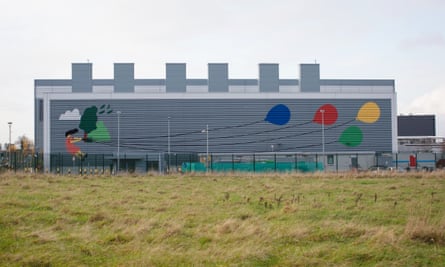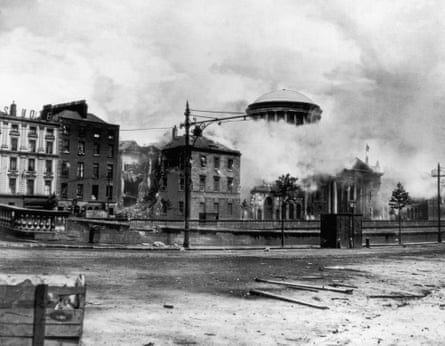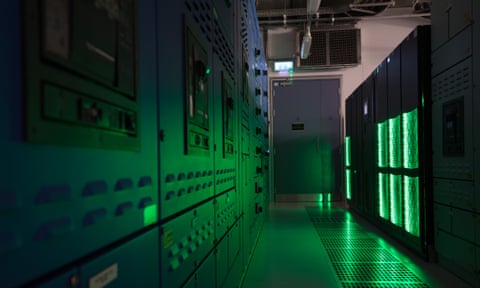In the doldrum days between Christmas and New Year, we take a family trip to see a datacentre. Over the past two decades, datacentres have become a common sight on the outskirts of Dublin and many other Irish cities and towns. Situated in industrial business parks, they are easy to miss. But these buildings are critical to the maintenance of contemporary life: inside their walls stand rows and rows of networked servers; inside the servers, terabytes of data flow.
It’s a seven-minute drive from where we live now in Artane, Dublin, to the Clonshaugh datacentre, situated in a business park behind Northside shopping centre. Although we live close by, we haven’t driven this way before, and our route takes us through a number of the local authority estates that my husband lived in as a boy. These estates are set on either side of a long, straight road pocked with chicanes to deter joyriders. Even though the housing development sprawls for miles on either side – with large wind-blasted green spaces in between – the houses huddle, squashed together. It looks as if someone has transplanted a warren of inner-city Victorian terraces to this desolate terrain.
My eldest daughter, who is six, sits in her car seat behind us and draws her impression of what a datacentre might look like. She shows it to me. It’s a large square, subdivided into many smaller squares. In the middle of each of the smaller squares swims a small tadpole-like dot. The effect is unsettling. “No windows?” I ask.
She considers this for a moment. “Mummy, this is the back of the building. The back bits don’t have windows.”
When Google Maps tells us we have arrived at our destination, we swing off the main road and into a newer cul-de-sac and park the car. To our right, small houses, their Christmas decor forlorn in the brownish-grey light of an Irish winter’s afternoon. To our left, the industrial park’s security-spiked fence, lining Clonshaugh Road as far as the eye can see.
In 2023, the consulting company Bitpower put the number of datacentres in Ireland at 82. Ireland’s Central Statistics Office reported in 2021 that these centres were using up to 18% of the country’s metered electricity, the same amount as every urban household in Ireland combined. The datacentre we’re visiting, situated in the midst of some of Dublin’s most impoverished council estates, was only the third to be built in Ireland. At 11,500 sq metres (about 124,000 sq ft), the Clonshaugh datacentre is small compared with the one Facebook opened in 2018 in Clonee, County Meath, which is about 150,000 sq metres (about 1.6m sq ft). A 2008 Irish Times article on the building of the Clonshaugh datacentre is optimistic in tone, quoting Cathal Magee, Eircom’s managing director of retail: “Customers get the ideal environment for their critical systems, as well as access to high-value technical specialists who are skilled at managing the hardware and software that businesses require.”
The Clonshaugh datacentre was developed by the US-based company Digital Realty Trust and is operated by Eir – the company that evolved from Ireland’s state-run Department of Posts and Telegraphs to first become Telecom Éireann, then the privately owned Eircom, via a disastrous flotation and shares scandal in the late 1990s. In January 2008, when Eir invested €100m in the Clonshaugh datacentre, Ireland was only months away from becoming the first country in the eurozone to enter a recession.
Yet the data centres survived the downturn, heralds of a new economy that promised to one day move the nation away from the banking and housing bubble that had left it bankrupt. Datacentres were one part of a longstanding vision of Ireland as a tech hub, a place where multinationals such as Google, Facebook and Amazon would base their European headquarters, attracted by the country’s well-educated workforce and – most importantly – the low corporate tax rate, which was 12.5% until 2023. (The average corporate tax rate globally is 23%; on 1 January 2024, Ireland increased its tax rate for large businesses to 15%, in line with guidance from the Organisation for Economic Cooperation and Development.)
Since the 1960s, Ireland’s Industrial Development Agency has had a policy of aiming to attract international investment through low corporate tax rates, starting with an initial rate of 0%. Ireland has long been home to tech companies: IBM and Ericsson offices opened in the 1950s, and factories owned by Dell, Intel, HP and Microsoft followed in the 1970s and 1980s. The focus of these operations was hardware. The pivot to software development coincided with the boom years of the early 2000s, when Ireland became known as the “Celtic Tiger”. Google’s European headquarters opened in Dublin in 2004, and since then, the country has become home to 16 of the 20 largest global tech companies.

In the nine years between the 1999 Eircom shares scandal and the 2008 Irish banking scandal, which exposed the country’s citizens to massive debt, Ireland enjoyed a period of rapid economic growth. Even as it struggled to exit recession in the 2010s, Ireland’s continued policy of low corporate taxation encouraged the growth of big tech in the country. The result is that Ireland’s economy is heavily dependent on tech companies, with low corporate taxes meaning that these companies contribute little to the Irish exchequer – and, by extension, to the Irish citizen left heavily indebted by the recession.
At Clonshaugh, we cross the winding road that skirts the industrial estate and follow a man walking a dog. He cuts through a door in the fence. It’s got a magnetic lock, but it’s resting open, and there’s a sign warning against leaving dog mess. To one side, a scrubby rise of overgrown grass and browning dock leaves, and on the other, the slick grey face of the datacentre. We stand and consider it. A low industrial hum fills the air: the sound of heavy machinery being operated some distance away. But the datacentre itself is silent.
My daughter begins to sketch what she sees, and as she does so, I move off and wander alongside the fence for a bit. Apart from a few cars parked in the car park, there is nothing to look at; it feels like the building itself is looking away. As with my daughter’s initial sketch, it’s difficult to identify the building’s front, although some panels of dark glass and a central door give a subtle hint toward ingress. The windowless grey facade is broken up by a number of grids, which look like part of the building’s cooling system. Ireland’s climate has been a major factor in attracting datacentres to the country – servers need to be kept cool, and Ireland’s temperate climate makes this easier. A 2023 Irish Times article notes that Iceland, too, is now trying to attract datacentre investment – the new 1,000-mile Iris cable, which runs along the seabed between Ireland and Iceland to create a direct cable link between the two countries, could make this plan more viable. Paired with Iceland’s cold climate, low population density and commitment to sustainability – all but 15% of Iceland’s energy consumption is sourced from renewables – this means that Ireland could offload some of its data processing to Iceland to help offset the catastrophic impact of datacentres on Ireland’s energy consumption. According to Ireland’s Environmental Protection Agency, Ireland will miss its 2030 carbon reduction targets by “a significant margin”.
As we walk around the datacentre’s fence, I notice a multitude of cameras around the building. A security guard in hi-vis clothing appears, talking into a walkie-talkie, perhaps wondering why this small family is hanging around the fence. I use my phone to take a picture of a planning permission sign.
There is very little of tangible value that could be taken from this building (although there have been incidents of thieves breaking into data facilities in the US and stealing computer equipment), but the data on the servers is precious, and any disruption to the building’s power supply could cost the companies that pay for storage here millions. As the number of datacentres in Ireland grows – planning has been approved for another 40 – so, too, will their energy footprint. The prospect of rolling blackouts has become more and more likely.

My daughter shows me a new drawing of the datacentre. Instead of a subdivided square, the building is now a subdivided rectangle. “Do you think it looks less scary now?” I ask.
“Yeah. But I still didn’t do any windows.”
If there were a window to peer through, what would I see? The internet shows me images of floors housing large servers, multiples of the kind we might be familiar with from our workplaces. About 30 people usually work in a datacentre, including security guards, cleaners and technicians, but this is a global estimate; our small Clonshaugh centre likely has far fewer. There are four or five cars parked outside the day we visit, but most people are probably still on holiday for the Christmas break.
Up to 88% of what is stored in the cloud is considered junk data that will not be accessed again by users. But the value of data lies in its scale: apps, websites and cookies track our day-to-day activities, and businesses can put this information to lucrative use in order to sell us things. Most of us consider our data safe when we save it to the cloud. As a writer, any time I complain about losing work or accidentally deleting a file, I’m asked the same question: “Didn’t you back it up in the cloud?” My email account recently threatened to stop working unless I bought more storage for the hundreds of photos and videos I’ve saved of my kids. After an afternoon spent deleting, I succumbed, and now my personal history is safely tucked away in the cloud for future use – isn’t it?
We drive back from Clonshaugh through Priorswood and Darndale, estates built during the 1980s, a time when Ireland suffered successive recessions, mass emigration and a heroin plague. The estates seem to have changed little since those days, even though the country as a whole has seen massive economic and social shifts, and I start thinking about the fragility of social and national memory. I wonder if datacentres such as the one in Clonshaugh will contribute to the kind of record-keeping Ireland has not always excelled at as a nation. Ireland is a country with a long memory, but a patchy one. We’ve just completed our celebrations of the Decade of Centenaries – a 10-year-long project to explore and reflect upon the decade in which the independent Irish state came into being.
The commemorations started with the 1913 lockout, a general strike that strengthened the labour movement that would ultimately support the 1916 Easter Rising. In the early 1920s, further violence erupted with the war of independence and then the civil war; the latter was a bitter internecine conflict that shifted the politics of Ireland away from the revolutionary ideals of the Easter Rising and toward the conservative Christian values that defined its 20th century. One of the conflict’s pivotal moments occurred on 30 June 1922, when the Public Record Office, a repository of more than 700 years of local records, was burned during a battle between the Irish Republican Army, which had rejected the terms of the 1921 Anglo-Irish treaty that brought the Irish Free State into being, and the Free State government. “It was an act of cultural vandalism,” said Catriona Crowe, the former head of special projects at the National Archives of Ireland. “For a long time people didn’t realise what we had lost.”

During the civil war, the Public Record Office – adjacent to the Four Courts building, where the anti-treaty IRA had stationed itself – was used as an armoury. When the pro-treaty side enlisted the help of British artillery – which it eventually did, four months after the initial occupation of the Four Courts – the Public Record Office suffered the worst damage. I think of the cameras hanging off the corners of the Clonshaugh datacentre, their domed glass lenses allowing them a 360-degree view of those who might come to threaten the flow of information.
The burning of public records “was a massive own goal”, Crowe told me. “It wiped out the history of the occupants of this island, most of whom kept no records.” She mentioned Slievemore, a settlement of 80 to 100 abandoned cottages on the slopes of Slievemore mountain on Achill Island, off the coast of County Mayo: “It was thriving before the famine. If we had the 1841 census, we would know the names, religions, occupations of the people.” The area was settled for more than 5,000 years. With the birth of the new state, we lost all record of that famine generation.
I asked Crowe what she thinks of digitisation in general, of the replacement of tangible records with a digital copy of each of our earthly transactions, stored among various servers. “Well, the first thing to say is that the most secure form of knowledge preservation is stone, and the oldest,” Crowe said. “After that, parchment – it survives all kinds of difficulties and remains robust. Then we had rag-based paper, from the 15th century onward, and after that acid paper cut from forests in the early 19th century. This deteriorates very quickly and needs to be kept stable. But by far the most unstable form is digital. We have a black hole opening in history. When Irish government departments started using computers in the 1970s, there was no network, and many of those files can’t be read any longer. There’s no real policy for digital preservation of state records. A nightmare is facing us. Emails, Excel, Word, PowerPoint – they’ll all vanish – unless there’s a decision made by the government.”
I have a little experience with the instability of digital files myself. In a past life, I worked on a project to digitise the extensive archive of Dublin’s Abbey Theatre, the English-speaking world’s first state-subsidised theatre. I was surprised by the projected speed of deterioration of the images we were creating for our database; and even Tiff files, which don’t degrade, may become inaccessible if the software used to read them becomes obsolete. And so all that material floating around in the cloud – which is in reality being bounced from server to server, degrading each time this happens – is not really being preserved in the way we might imagine. Its continued existence is dependent on a steady flow of electricity, the continued provision of which is contingent upon governments reaching renewables targets they can’t agree upon. And even then, these files will degrade, deteriorate and become obsolete. Rather than creating something permanent and inviolable, we’ve made our memories more contingent than ever upon a fantasy of technological stability that, given the constant churn of history, seems inevitably fleeting.
As world temperatures increase, datacentres have migrated to places where the climate is temperate. There, they consume vast amounts of energy, increasing carbon emissions. It’s a frightening and seemingly unsustainable pattern; we’ve entrusted our memories to a system that might destroy them, and us. Because of this fraught reality, datacentres in Ireland have become controversial in the past five years, and the tone of the newspaper articles discussing them has changed. It’s suggested that if all the datacentres currently proposed in Ireland are built, they could be using up to 70% of the country’s electricity by 2030.

Reliance on fossil fuels and on-site generation has remained a concern for environmentalists in the intervening years, with close scrutiny being paid to developers’ commitments to contributing to Ireland’s renewable power grid. The journalist Aoife Barry, in her research for her recent book Social Capital, has identified the ways in which multinationals are greenwashing their contribution toward renewables, including the case of a high court review of a planned Apple datacentre in County Galway in 2018:
“The board sought more information on the plans, saying there was a lack of clarity around ‘direct sustainable energy sources’, including how Apple would live up to its promise of running on 100% renewable energy. When Apple submitted a revised environmental impact assessment to the council, it indicated that it wouldn’t be generating renewable energy itself. Instead, it would buy renewable generated power from an energy supplier ‘equal to the total power consumption of the datacentre building in any particular year’.”
This equation works out only if energy demands don’t continue to rise in the coming years, meaning any renewable investment is going to continue to lag behind the needs of the expanding datacentre sector.
In an effort to entice further foreign direct investment, the government has implemented measures aimed at streamlining the planning process for datacentres, which would allow concerned citizens less visibility into the estimated environmental impacts of these centres. Decreasing transparency in this instance seems unnerving, and symptomatic of the Irish state’s strange relationship with multinationals. In 2016, the Irish government rejected the European Commission’s ruling that Apple should pay Ireland €13bn in unpaid taxes, arguing that the lower corporate taxation rate the country offered at the time makes Ireland more attractive for investors. The logic behind that decision might have been confusing to everyday Irish citizens, given that at that time they were each saddled with €42,000 in debt accrued after the International Monetary Fund’s bailout of Ireland’s banks.
Datacentres have contributed €7.3bn to the Irish economy, but provide only about 16,000 jobs to a country of 5.28 million people. The lack of employment these centres provide leads to questions over who benefits from their existence. In August 2022, after two consecutive amber alerts for electricity outages in Ireland, then-finance minister Paschal Donohoe appeared on national broadcaster RTÉ’s radio show Morning Ireland, where he was quizzed about the low employment figures at datacentres and the fact that their profit margins were soaring while electricity bills had reached new highs for Irish citizens. He dismissed the lack of employment, emphasising instead the “huge importance of them to really large employers within our country, whose taxes and jobs are playing an invaluable part in our economic performance at the moment”.
The benefits of the data centre economy are diffuse, intangible. In 2022, due to concerns about pressure on the National Grid and the potential for rolling blackouts, EirGrid, Ireland’s energy grid, placed a moratorium on the development of new datacentres in Dublin until 2028. But applications for centres outside the capital are still being granted. Other European countries, such as the Netherlands, are halting their development of datacentres. Singapore imposed a three-year moratorium from 2019 to 2022, and is now seeking applications within new parameters to ensure sustainability. Unless Ireland figures out a way to surge forward with its slow development of renewables, these datacentres seem impossible to sustain. One potential solution is to look more carefully at what data we retain, and why. We must weigh the short-term financial benefits of seemingly infinite data retention against the long-term threat of climate crisis.
Ireland is no exception to the rule that what we remember and what we forget are always contingent upon the power structures and hierarchies that shape our contemporary moment. At the birth of the state, we burned our history in an act of carelessness; we also freed ourselves to create a new national history. We entrusted the church with our moral guidance and guardianship, and then allowed it to commit unspeakable cruelties on our citizens, including the abuses recounted in the Report of the Commission to Inquire Into Child Abuse (2009) and the Commission of Investigation Into Mother and Baby Homes (2021). At the latter end of the century, and in the wake of joining the EU, we moved away from our old bad memories and toward a prosperous new era, placing our faith in international investment, almost at any cost. But in a small country like Ireland, the old names – whether they be companies or state organisations or political dynasties – crop up again and again. Sometimes our faulty memories flash up a warning. But often that history is stored in the cloud: intangible, vulnerable to exploitation – and degrading over time.
This article first appeared in issue 13 of The Dial
